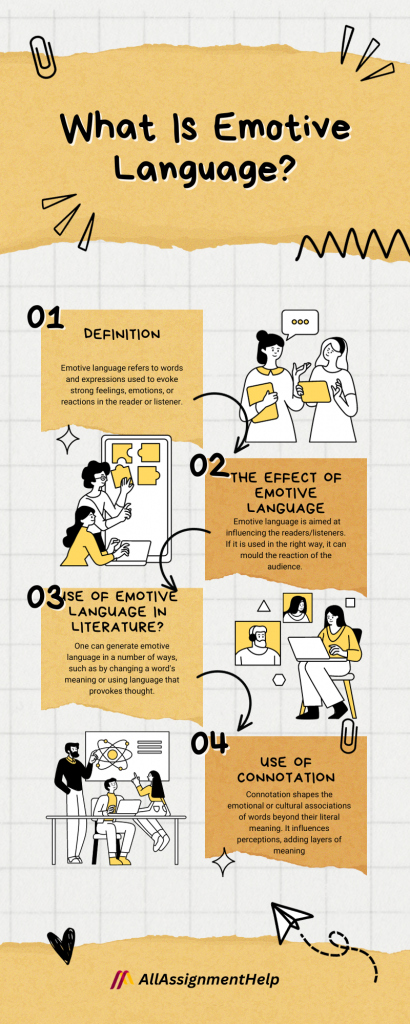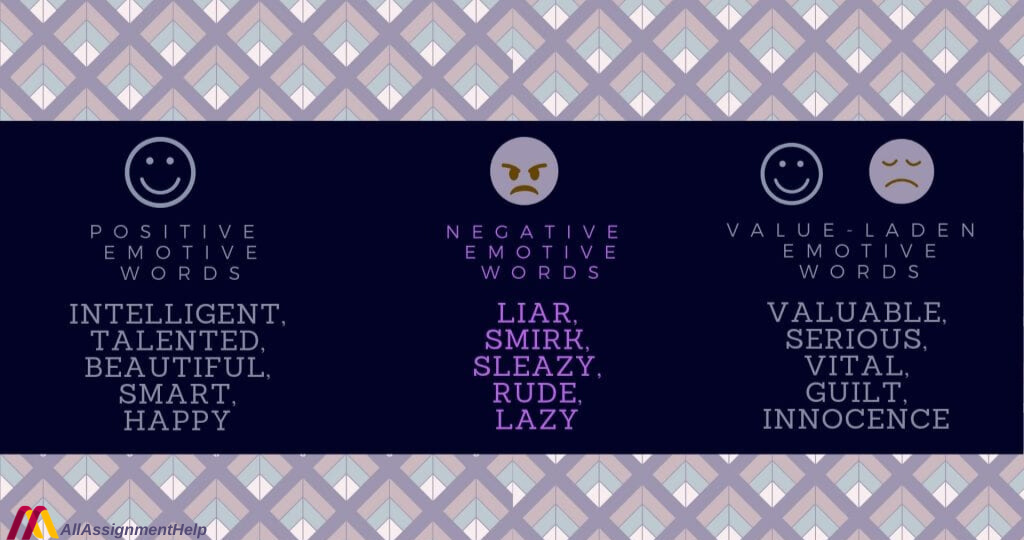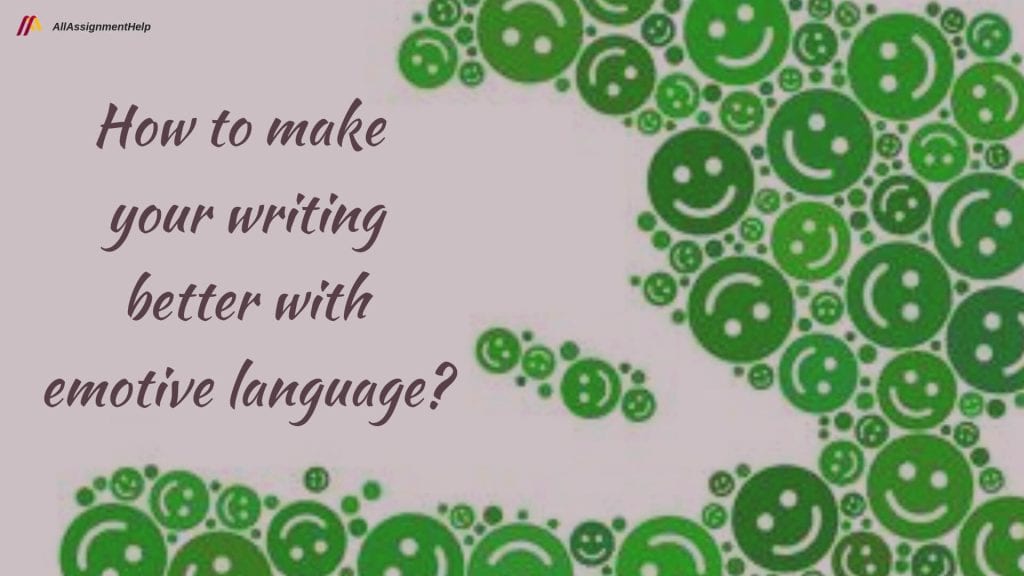Table of Contents
Hello readers, We are back with another concept which can help add freshness to your writing. Be it your essays or any other narration, the right use of emotive language can help you immensely. If you find it hard to learn, then you must go through this blog. From emotive language definition to its example and effect you have too many things to know. Apart from this, you can also avail academic assistance in your learning phase.
So read this blog which is curated by the expert at allassignmenthelp, this can help you learn things from a unique perspective.
Let’s know what all you can know in this blog post and quickly move to their detailed description:
– Emotive language definition
– How to use emotive language in literature?
– Effect of emotive language
-What is connotation?
What Is Emotive Language?
One of the key elements of creative writing is word choice, as different words can significantly impact how a text is perceived, including its voice and tone.
The utilization of emotive language is a critical strategy for captivating readers with content. Emotive language, often referred to as “loaded language,” emerges when writers intentionally select words to evoke specific emotions in the reader.
This type of language holds the power to forge a connection between the writer or speaker and the readers. This is because the subconscious minds of readers or listeners tend to memorize information more effectively when presented in a manner that resonates with their emotions. The impact of emotional discussions can be observed in your surroundings.
Emotive language definition

Emotive language refers to words and expressions used to evoke strong feelings, emotions, or reactions in the reader or listener. The primary purpose of using emotive language is to create an emotional response and engage the audience on a deeper level. This type of language often involves the use of vivid and descriptive words that can elicit specific emotional reactions, such as joy, anger, fear, sympathy, or excitement.
Writers, speakers, advertisers, and communicators use emotive language strategically to influence the audience’s perceptions and attitudes toward a particular subject or issue. By appealing to the emotions of the audience, they aim to establish a connection, provoke empathy, or inspire a desired response.
Emotive language can be employed in various forms, including adjectives, adverbs, metaphors, similes, and other figurative language devices. It plays a crucial role in persuasive writing, speeches, marketing, and other forms of communication where the goal is to sway opinions or create a memorable impact.
Emotive Language Example
You may get a better understanding of the concept by reading the explanation and knowing the definition of emotive language. Here’s an example that should help you understand it better. We have penned down two different sentences showing almost the same gestures. It will show you the difference between normal sentences and an emotive sentence.
Let’s have a look at it:
Statement without emotive language: “The company is facing financial challenges, and layoffs are necessary to streamline operations.”
Statement with emotive language: “The company is grappling with severe financial hardships, and unfortunately, we must make the heartbreaking decision to lay off some of our dedicated employees to ensure the survival of our business.”
In the second statement, emotive language, such as “severe financial hardships,” “heartbreaking decision,” and “dedicated employees,” is used to evoke a stronger emotional response from the reader. This type of language aims to make the situation more relatable and elicit empathy or understanding.
It can be difficult and complex to comprehend language that conveys emotion. To answer all of your questions about using emotive language in writing, we advise you to use an online custom assignment writing service.
Examples of emotive language in daily life?

In our overview, we’ve focused on an important theme
We intentionally chose literature as a starting point because it lays a solid foundation for grasping the idea. But remember, emotional language isn’t just limited to literature—it’s all around us in everyday life.
Take a moment to revisit the emotive language definition. This expressive form of communication is ubiquitous in our daily interactions. If you haven’t contemplated its significance, peruse the examples below to witness its simplicity and accessibility in understanding. Here’s how we seamlessly incorporate it into our day-to-day conversations:
Frequently, news headlines employ emotive language to captivate their audience. Consider these illustrative examples:
- The disruption in public transport is not just inconvenient; it’s genuinely distressing. (Here, the words “distressing” and “disrupting” add a poignant emotional layer.)
- The current situation is not just challenging; it’s truly dire, and it will worsen unless we take decisive action. (In this case, the use of “awful” emphasizes the emotional gravity of the situation.)
Now, We will just provide you with some more examples, and you have to assess them on your own. Here, we go:
-An innocent passenger was brutally murdered in a train robbery.
-A monster of a man violated an underage child’s decency.
-The sleeping victims were attacked under the cover of night.
Hope you caught the words which make the sentences and facts emotive. If not, then relax it is not always easy to do such things first time for some people. I will explain to you why these sentences are an example of emotive language. I will surely help you to find the words that evoke the emotional aspect of the reader. Here they are:
Explanations of examples
In the very first sentence, there are words “innocent” and “brutally.” Both of these are the medium of evoking emotion. Hence, as per the emotive language definition, they are an example of emotive language.
Now, let’s talk about the second sentence. In this one, the words “monster,” “child,” “decency” and “underage” show the emotion. Thus, in accordance with the emotive language definition, we can categorize them as apt examples.
Moving to the third and last one, let me tell you the words quickly. They are “sleeping,” “cover of night” and “attacked.”
The Effect of Emotive Language
As we already know emotive language is aimed at influencing the readers/listeners. If it is used in the right way, it can mould the reaction of the audience. This is because emotive language is a technique of persuasive writing. This clearly means that it aims at persuading the audience to think a certain way.
You can also consider it as a manipulative technique. At times, the audience can question the speaker/writer back. These things are a part of using this language.
But if you need more help with the various technical specifics, you may consult a professional expert writer. Hiring a specialist will enhance your learning even more. The specialist will assist you in resolving all of your issues and prepare you to become proficient in many aspects.
PRO TIP:
Never ever overuse emotive language (This can turn things completely against you, and you may end up in committing a blunder.)
Why And How Emotive Language Is Used In Literature?
One can generate emotive language in a number of ways, such as by changing a word’s meaning or using language that provokes thought.
Some words make us feel a specific way. Reading is not merely about processing information objectively; for instance, the word “gun” arouses terror, but the phrase “puppy” arouses delight. Words, whether you realize it or not, influence our perception of reality!
Literature is written with a purpose in a writer’s mind. In general, that purpose is to convey thoughts or ideas to readers. Mostly, the theme or thought which the author wants to communicate is something close to his/her heart. While writing something for unknown people, it becomes very important to pen down the thoughts in a way that the readers find it relatable.
This is why various language techniques are frequently used in literature. To make a story, a novel, a novella, a poem or anything relatable it has to be evoking. Thus, it would be illogical to remove emotions from the text.
To know how it is used in literature, you will need to go through examples, which follow:
Example:1 Martin Luther King
“Martin Luther King”… The name alone transports you to a bygone era. Many of us are familiar with the world he inhabited and the aspirations he held throughout his life. Thus, when encountering a sentence from his speech, you are expected to resonate with the historical context.
Now, let’s analyze the excerpt…
Dr. Martin Luther King, Jr. evokes emotional responses from his audience through his compelling rhetoric.
One powerful employment of rhetoric in his speech is the use of emotive language.
Here is an excerpt to illustrate:
“One hundred years later the life of the Negro is still badly crippled by the manacles of segregation and the chains of discrimination. One hundred years later the Negro lives on a lonely island of poverty amid a vast ocean of material prosperity.”
Here, King Jr. uses emotive (and figurative) language to shake up his listeners. He intends them to feel bothered; he wants them to feel. Doctor King wants them to realize the need for action. He wants them to participate in the Civil Rights Movement.
This is how emotive language is used.
This is how emotive language is used. Students often consider professional viewpoints to understand these concepts. They might also get English assignment help from professionals to improve their work and get higher grades.
You can understand it better by another example:
Example:2 Ronald Mhasvi
“The dry cracks of the mind fill up the sand
Dusty acres of self-doubt spread,
Creeping jaggedly on,
Leaving in their wake, like the runs
Of an ancient civilization
The broken fragments of a despairing vision
Sorrows that come hurtling down mind walls and
Smash into blood clots that echo
In the empty chambers of a lonely heart.”
This is an excerpt from the poem “Dawn 1984” by Roland Mhasvi.
“Sorrows” an abstract feeling is objectified and is made a moving object. It is shown that “sorrows” are inflicting pain in the mind (down the mind’s walls). These sentences create despair in the atmosphere. It tells a darker side to the reader.
The stench of sorrow probably typifies the author’s assessment of the situation at the time of writing the poem. These lines are written with the motive of evoking the vicarious experience. This is because that experience can push the reader poem evoke a vicarious experience in the reader that can connect him/her with the poetry. This can push one to involved in the poem mentally and emotionally. As a reader reads through the poem, it impulsively forces one to imaginatively experience and share the same things as the characters in the story.
Are you not intrigued by the idea of using this language? You only need to pay close attention to see additional examples. Just remember the definition of emotive language and give it another go if you’re having trouble identifying the emotive terms.
What Makes Emotive Language Complete?
Connation is the term which complete emotive language. How? Let’s see
These two language approaches are both often and efficiently employed. Since they are both components of persuasive language strategies, they have the potential to be the most effective at swaying readers.
These two have the power to evoke strong emotions in the reader or listener when used appropriately. Both of them are typically obvious to find in the text. But exceptions are always there. Sometimes the meaning of the words gets too complex to understand. You need to be able to recognize and investigate the consequences of argumentative and emotive language if you are going to be successful in your analysis.
Before you master analysis of the techniques, you should first ensure that you have a sound grasp of the basics emotive language and connotations.
Seeking expert assistance is always an option if you find that obtaining information is a difficult task. On the other hand, you can choose to use online coursework services, which assist students with anything from learning to finishing assignments. All of them are included within one.
Let’s make it easier
The best way to grasp connotation is by considering colour associations; it is undeniably the easiest and most effective method for comprehending the concept. Regarding colors, each hue is intricately linked to various emotions. For example:
- We instinctively associate red with danger, anger, aggression, or passion.
- White is renowned for evoking feelings of peace and purity.
- The color black is commonly connected with themes of death.
Moreover, nuances in shades further contribute to distinct interpretations. It’s worth noting that authors or speakers might intentionally play with connotations to draw attention to, or subvert, particular associations.
Examples: Here is an extract from one of the speeches of Elizabeth I. This particular one, you can observe here emphasises the inspirational strengths and talks about physical limitations as well.
‘I know I have the body but of a weak and feeble woman, but I have the heart and stomach of a king …’
Here you can see how Elizabeth has talked in a way in which the literal meanings of the words are of no importance. She has used the words “heart” and “stomach” as connotations. No one can say that she intends to convey the literal meaning of these words. This is because it can be seen that by “heart” and “stomach” she is referring to her spirit, valiance, and courage.
The listeners, or say the readers (as of now) can easily understand that she is explaining herself as a woman who lacks the physical attributes of a man but also possesses the strength and courage (especially the inner strength). She is comparing herself to a king, one can interpret that she is a woman in the men’s world, who can stand on her own and for her people as well.
Time to get into an analysis
Analysis of emotive language and connotation
Now, when we have discussed both concepts in length. it is the right time to analyze them both. The need for doing so is to recall what we have read so far and also check whether we understood them in the right manner or not.
So, let’s start analyzing them.
1. FOCUS ON SPEAKER’S INTENTION
The speaker’s or writer’s intention should be the first thing on which to concentrate. Determine the kind of emotional response that the writer or speaker is hoping for from the readers or listeners. For example, what kind of feelings he has—happiness, pride, pity, etc.
2. REACTION OF AUDIENCE AND OVERALL PURPOSE
Secondly, you need to focus on how the emotional reaction of the audience will relate to the writer’s overall purpose.
3. PLACEMENT
Another main aspect to consider while analyzing language techniques is “placement.” If a writer starts with angry phrases, might this turn off or enrage the intended audience? Whether it is making a “them and us” scene with which the audience might identify or not. It is important to consider emotive language in the context of the purpose which you want to present in your writing.
Below, I am listing three questions which you need to answer. You should do this because they will help you to analyze better.
Ask yourself
- How does the use of emotional language changes as per the purpose of being showcased?
- Does the emotive language arouse or soften depending on what is being discussed?
- What types of connotations would different readers react to?
You should keep one thing in your mind factors like political interests, religious beliefs, socioeconomic factors, age, and gender impact the effects that emotive language and connotations can have on the readers. Be aware that different people have different perspectives and this is why they perceive different meanings from the same text.
PRO TIP:
Now, you have read the emotive language definition and what is connotation. You have understood their examples as well. In all, you are well-versed with all the details. I hope you will come up with astounding written work. But, it is always better to be on the safer side. This is why I would advise you to check out all your write-up before finalising it. In case you don’t have time to do so, ask experts to proofread and edit your draft. It is a must to do, or else minor errors will affect your efforts adversely.
Wrap Up
To assist you in understanding how to use emotive language to improve your writing, we started by defining it. After that, the impact and use of this language in literature were discussed, along with a few examples from daily life.
Next, we discussed connotations, which are crucial to comprehending to using language appropriately. Finally, we reached a thorough analysis of both concepts. Now we believe that you’re able to use metaphors and expressive language because you comprehended every idea well enough.
FAQs
| What are the advantages of speaking and writing with emotion? Emotionally charged language has the potential to evoke strong feelings in readers and build a rapport between the writer speaker and. |
| What are the advantages of speaking and writing with emotion? Emotionally charged language has the potential to evoke strong feelings in readers and build a rapport between the writer or speaker and. |
